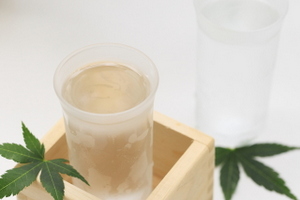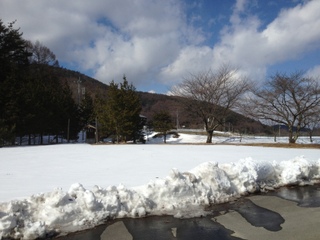What temperature should sake be served at? This seems to be a hot topic at the moment (terrible pun, I couldn’t help myself…), it’s a question I’m often asked, and I guess it’s time to throw my 2 cents into the public arena.
 I was always confused. Hot or cold? What was the difference, really? I asked my jujustu instructor in Chiba once, and his answer was sublime. He said, looking a little embarrassed on my behalf for having voiced such a foolish question, “if it’s really cold outside, then… maybe you should drink it warm?” Having stayed a night in a house where a thin layer of paper was all that was between me and the cool chill outside, I couldn’t really argue with the wisdom of this.
I was always confused. Hot or cold? What was the difference, really? I asked my jujustu instructor in Chiba once, and his answer was sublime. He said, looking a little embarrassed on my behalf for having voiced such a foolish question, “if it’s really cold outside, then… maybe you should drink it warm?” Having stayed a night in a house where a thin layer of paper was all that was between me and the cool chill outside, I couldn’t really argue with the wisdom of this.
It is true, different beverages respond to difference temperatures, which anyone who has had the chance to enjoy real ale straight from the cask can appreciate. But in saying this, you can also do shots of your ‘Hill of Grace’ shiraz from the fridge, you can hammer down that Grand Cru Chablis at 40 degrees, but should you?
Really?
Tokuteimeshoushu, or special designation sake, responds best to being chilled. There, I said it. To heat tokuteimeishoushu, especially in the case of a Daiginjo, would be… how can I put it? Simply wrong. And this is all because heating sake exaggerates the impression of the alcohol on the nose, while the subtlety, the fruity bouquet of the ginjos and floral delicate daiginjos, is destroyed.
At least that is what I used to think.
AND I WAS 100% WRONG!
I’ve heard many different opinions over years, but I think that the fact of the matter is, like many things in the sake world there are no hard and fast rules. Up until my last trip to Japan I was a chilled-sake-snob, proudly professing in my ignorance that while there have been many chilled sake I’ve loved, there’s never been a hot sake that’s interested me. Now I have reassessed my naive view, in part due to a phenomenon outside of even the greatest of brewer’s hands.
Winter.

Fujita-San, the President of Mioya Shuzo, the company behind the Yuho brand, believes that this ability to be served at different temperatures is one of the many great things that makes sake so special. Different sakes have different sweet spots, part of the joy of drinking then is finding out where these sweet spots are, and how the beverage evolves as the temperature changes.
‘But this was a straight junmai’, I hear you say. What about ginjo sake? Surely not?
Actually, surely.
At Kozaemon Brewery, in Gifu prefecture, I was lucky enough to try ten or so junmai and junmai ginjo, first chilled, and then at 45 degrees and 40 degrees respectively. The changes in profile were massive, and it’s true that the impact on the nose of the alcohol presented a different dynamic when the sake was heated, it was in no way unpleasant. Again the spice aspect was lifted, cinnamon, figs, custard, custard apple. Awesomeness.
‘But what about daiginjos? Are you crazy?’
Yes. At a Dassai tasting event in Akasaka this February I was treated to many amazing Dassai products, one of which was a Dassai 50 at about 40 degrees. I’m not going to lie, I wasn’t expecting much, but again I was very pleasantly surprised. Instead of the heat blowing the bouquet away, other delicate flavours and aromas came through, such as honey, caramel, and baked banana. It was, wait a minute, what’s the word?
Awesomeness.
I’m not saying that I’ve switched camps, that I’ve changed sides and hot is the only way to go. Chilled sake is still my preferred drink. But I have had occasion to better understand the shear awesomeness of this beverage from a previously unappreciated angle. There is definitely a place for heated sake. Don’t let anyone tell you different.
On that subject, someone bring me a nice hot bottle of Krug!
………………………………………………………………………………………………………………………………………………………………………
 |
Wayne Shennen According to Wayne Shennen, good bartending is all about balancing flavours. “The subtlety of each ingredient should shine through,” explains the passionate New Zealander, a trained sake sommelier and one of Sydney’s most respected bartenders at award-winning Saké Restaurant & Bar. “If you can taste what you’re drinking, you tend to treat alcohol with more respect.”a Having earned his stripes behind bars in Sydney and the UK, Wayne is now gaining a following of fans who appreciate his original cocktail mixes and extensive knowledge of sake and shochu. “At Saké Sydney I’m given free reign to play – our bar staff all have a great knowledge of classic cocktails and we use this as the basis for getting innovative. We also have access to the world’s finest sake and shochu varieties,” says Wayne. “My goal is to make Saké famous for its drinks!” |
Saké Restaurant & Bar
12 Argyle Street, The Rocks, Sydney
T. 02 9259 5656
The Sake Alchemist #7
The Sake Alchemist #6
The Sake Alchemist #5
The Sake Alchemist #4
The Sake Alchemist #3
The Sake Alchemist #2
The Sake Alchemist #1
Tasting Business at Saké Restaurant & Bar





